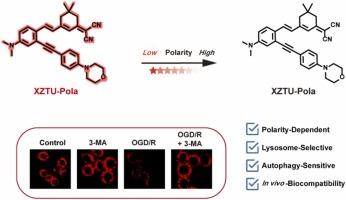基于溶剂可调旋转势垒的极性响应探针:从分子设计到细胞自噬应用
IF 3.7
1区 化学
Q1 CHEMISTRY, ANALYTICAL
引用次数: 0
摘要
荧光探针广泛应用于生物成像,以监测细胞微环境的物理化学性质。然而,当溶酶体等细胞器同时经历极性和粘度的变化时,由于荧光信号中复杂的相互作用,传统的探针设计往往不能准确地解释微环境的变化。为了解决这一挑战,我们开发了一种创新的基于溶剂可调旋转势垒(STRB)的荧光探针XZTU-Pola,它通过一个morpholine基团(Pearson系数= 0.94)有效地靶向溶酶体,并结合了乙炔桥接的苯基morpholine和ADM结构,以获得敏感的极性响应。实验结果表明,XZTU-Pola在甲醇和四氢呋喃中表现出几乎相同的吸收波长,表明在这些溶剂中激发后构象发生了变化。在荧光光谱中,XZTU-Pola在甲醇中几乎不发射,而在四氢呋喃中显示出明显的荧光发射(荧光强度增加约160倍),与溶剂极性呈负相关。理论计算表明,溶剂极性调节XZTU-Pola的旋转势垒,在非极性溶剂(局部激发态,f=0.466)中,旋转势垒为2.99 eV,在极性溶剂(扭曲分子内电荷转移态,f=0.0047)中,旋转势垒降至2.08 eV,导致荧光强度发生较大变化。在生物系统中的进一步应用表明,XZTU-Pola精确监测自噬过程中溶酶体极性的动态变化,表现出显著的抗干扰性。这些发现强调了XZTU-Pola在细胞极性成像方面的广阔潜力,为相关疾病的研究提供了新的技术途径和理论基础。本文章由计算机程序翻译,如有差异,请以英文原文为准。

Solvent-Tunable Rotational Barrier-Based Polarity-Responsive Probe: From Molecular Design to Cellular Autophagy Applications
Fluorescent probes are extensively employed in biological imaging to monitor the physicochemical properties of cellular microenvironments. However, when organelles such as lysosomes experience simultaneous changes in polarity and viscosity, conventional probe designs often fail to accurately interpret microenvironmental alterations due to complex interactions in the fluorescence signals. To address this challenge, we have developed an innovative solvent-tunable rotational barrier (STRB)-based fluorescent probe, XZTU-Pola, which efficiently targets lysosomes through a morpholine group (Pearson coefficient = 0.94) and incorporates an acetylene-bridged phenylmorpholine and ADM structure for sensitive polarity response. Experimental results show that XZTU-Pola exhibits nearly identical absorption wavelengths in both methanol and tetrahydrofuran, indicating conformational changes upon excitation in these solvents. In fluorescence spectroscopy, XZTU-Pola is almost non-emissive in methanol, while it displays significant fluorescence emission in tetrahydrofuran (approximately 160-fold increase in fluorescence intensity), exhibiting an inverse correlation with solvent polarity. Theoretical calculations reveal that solvent polarity modulates the rotational barrier of XZTU-Pola, with a rotational barrier of 2.99 eV in non-polar solvents (local-excited state, f=0.466), which decreases to 2.08 eV in polar solvents (twisted intramolecular charge transfer state, f=0.0047), leading to substantial changes in fluorescence intensity. Further application in biological systems demonstrated that XZTU-Pola precisely monitors dynamic changes in lysosomal polarity during autophagy, exhibiting remarkable resistance to interference. These findings underscore the broad potential of XZTU-Pola for cellular polarity imaging, offering a novel technological approach and theoretical foundation for the study of related diseases.
求助全文
通过发布文献求助,成功后即可免费获取论文全文。
去求助
来源期刊

Sensors and Actuators B: Chemical
工程技术-电化学
CiteScore
14.60
自引率
11.90%
发文量
1776
审稿时长
3.2 months
期刊介绍:
Sensors & Actuators, B: Chemical is an international journal focused on the research and development of chemical transducers. It covers chemical sensors and biosensors, chemical actuators, and analytical microsystems. The journal is interdisciplinary, aiming to publish original works showcasing substantial advancements beyond the current state of the art in these fields, with practical applicability to solving meaningful analytical problems. Review articles are accepted by invitation from an Editor of the journal.
 求助内容:
求助内容: 应助结果提醒方式:
应助结果提醒方式:


